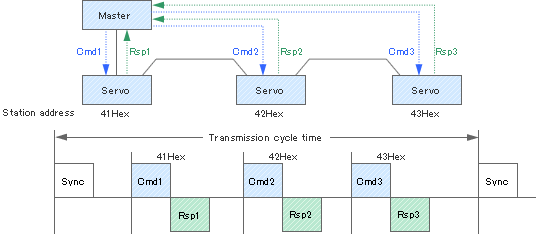An Overview of MECHATROLINK-Ⅱ
MECHATROLINK-Ⅱ is a bus network allowing a maximum of 30 node addresses and supporting comm. cycles of 0.25 to 8 ms. All SDevice stations on the network can be run synchronously. Although MECHATROLINK-Ⅱ is specialized for motion control applications, it also allows a remote I/O signals to be connected to the same network.
∗ A controller, PLC, or similar device connected to the network is referred to as a “Main Device (abbreviation: MDevice)”. A device such as a servo drive, AC drive, or I/O device is referred to as a “Subordinate Device (abbreviation: SDevice)”.
Features
- High-speed communications at a baud rate of 10 Mbps and a minimum transmission cycle time of 250μs.
- Connects up to 30 SDevice stations to a single C1 MDevice station.
- Support Tools can be connected as C2 MDevice stations.

*: Connect a terminator each at each end of the network cable. The black square (■) represent a terminator.
- The transmission cycle time can be set to the optimum value between 0.25 and 8 ms according to the number of stations connected and amount of data transmitted.
- Perform high-reliability communications using a cyclic redundancy check (CRC) and other features in a communications ASIC.
- Assures high-reliability communications with each command from the MDevice implemented alternately with a response from the corresponding SDevice.

- The cable can be extended to up to 100 m by using a repeater.

Notes: 1. Keep the network cable lengths on both sides to a maximum of 30 m if 30 stations are connected.
2. A repeater must be used in the following cases as well.
・If 16 SDevice stations are used in a network that is more than 30 meters long.
・If more than 17 SDevice stations are used.
Maximum Number of SDevices
MECHATROLINK-Ⅱ can transmit 17 or 32–bytes of data per SDevice. The following table shows the maximum number of SDevice to be connected in accordance with data size and transmission cycle.
| Transmission Cycle Time (msec) |
Number of SDevices | |
|---|---|---|
| 17byte | 32byte | |
| 0.25 | 2 | 1 |
| 0.5 | 7 | 4 |
| 1.0 | 15 | 9 |
| 1.5 | 23 | 15 |
| 2.0 | 30 | 21 |
| 2.5 | 30 | 26 |
| 3.0 | 30 | 30 |
| 3.5 | 30 | 30 |
| 4.0 | 30 | 30 |
| 4.5 | 30 | 30 |
| 5.0 | 30 | 30 |
| 5.5 | 30 | 30 |
| 6.0 | 30 | 30 |
| 6.5 | 30 | 30 |
| 7.0 | 30 | 30 |
| 7.5 | 30 | 30 |
| 8.0 | 30 | 30 |
Notes: 1. This data in this table also serves as the communication specifications for MECHATROLINK-Ⅱ.
Some MDevice devices may support fewer SDevice than are listed here.
2. No retries or C2 MDevice devices
Hardware
Communications ASICs
Three types of MECHATROLINK-Ⅱ communications ASICs are available, including a MDevice ASIC, a MDevice/SDevice ASIC, and a SDevice ASIC. The SDevice ASIC is compact and inexpensive, and ensures easy SDevice development.

Two-mode MDevice & SDevice:
JL-080B (5V)
MDevice only:
JL-098B (3.3V)

SDevice only:
JL-052C (3.3V)
14mm□
Connector
A MECHATROLINK connector is similar to a USB connector with a locking mechanism that locks into the port. It can be easily and securely connected.

MECHATROLINK-Ⅱ Connector


